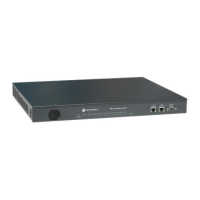System Administration
Motorola, Inc. 570510-001-00 rev A Page 19 of 50
S
S
y
y
s
s
t
t
e
e
m
m
A
A
d
d
m
m
i
i
n
n
i
i
s
s
t
t
r
r
a
a
t
t
i
i
o
o
n
n
This User Guide covers the commands relevant to the T3 PowerBroadband Switch. For a complete set of
commands and information, consult the T3 PowerBroadband Command Reference.
M
M
a
a
n
n
a
a
g
g
e
e
m
m
e
e
n
n
t
t
A
A
c
c
c
c
e
e
s
s
s
s
T3 can be managed via serial console, telnet, HTTP webUI, or SNMP. Eth1 is enabled by default. Telnet and
HTTP are accessible at the default IP address.
Access Methods
Default IP address
192.168.1.3
Serial console
Terminal settings: 9600-8-N-1 no flow control
Telnet
Uses TCP port 23
HTTP
Browser support: IE6 or greater, Mozilla based browser
Management URL: http://<IP address>
IP Port: 80
Default login and password
Default user name for administrative access: admin
Default password: <blank>
Default user name for monitoring only: user
Default password: <blank>
C
C
L
L
I
I
C
C
o
o
n
n
f
f
i
i
g
g
u
u
r
r
a
a
t
t
i
i
o
o
n
n
S
S
c
c
r
r
i
i
p
p
t
t
f
f
i
i
l
l
e
e
s
s
T3 file system stores and load configuration script files. These files are text editable. Use the following
commands to complete these management tasks:
1. Create a starting configuration file from an existing T3 switch
2. Copy the file to an external server
3. Edit the file on a PC
4. Load the file into another T3 switch
5. Execute the file as a set of configuration commands
The command syntax to use the file system is:
file copy <string(source)> to <string(destination)>
a. Source can be a local file, a remote FTP or TFTP file, or a pre-defined keyword. Keywords allow you to
capture the startup and running configuration to a file. Supported keywords are “startup” and “running”.
b. Destination can be a local file or a remote FTP or TFTP file. Note that the combination of the Source
keywords and the remote Destination allows you to copy the running config directly to a remote server. For
example; file copy running to tftp://192.168.1.1/my-t3-config.txt
c. At least one (source or destination) must be the local file system. If the source and destination are remote
servers, the command will fail.

